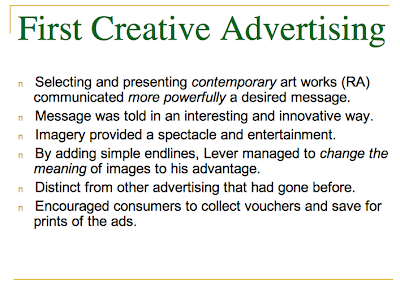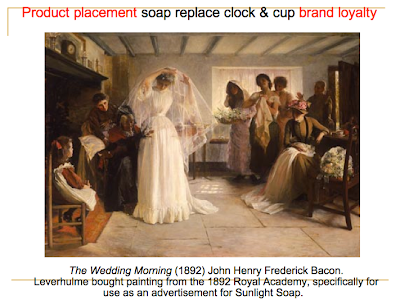The beginning
Robin Wight
'Advertising is the most fun you can have with your
clothes on' Radio 4 interview, 2009
Wight is most famous for the 118 118 and the futures bright, the futures orange campaigns.
William Hesketh Lever and Bill Bernbeck were also very popular in the advertising industry. With Lever was one of the founders of Port Sunlight in 1885, a museum which tells the story of the birth of creative advertising. His brother was also one of the founders; James Darcy.
Lever was a British business tycoon who also foundered the Lady Lever Gallery. This gallery was built within a village, next to a soap factory.
The Great Exhibition
This etching is an image of where Britain was during the time. This image at the top is of a crystal palace which contains the courts where British goods are kept.
Advertising an essential
'An essential component of any competitive market economy: driving growth and dynamism' (Hegarty, 2011, p7)
Britain at the time was the most powerful country in the world.
Pre-Packaging
Soap was used to wash the body and clothes. Lever was the first to advertise a bar of soap and he made it into a necessity not an item you wanted. Lever was the first to ad brand value to soap.
In 1850's and 1860's news and advertising were interdependent.
This is still the case as The News of The World closed down after the phone hacking scandal with meant advertising companies withdrew their ads from the paper.
Lever Brothers were the first multinational company.
Unilever were also the largest co-operation in the UK (1930)
Lever used contemporary paintings which he added type to. He chose specific paintings featuring women, children, linen, lace and other delicate white materials.
'The disrupting of a sequence and narrative by juxtaposing items from different sources. It is the construction of a work by editing or putting together previously unrelated elements' (Graphic Design as Communication, Malcolm Barnard)
The Alice in Wonderland exhibition in Liverpool featured photos from the 1800's. The photographer, Lewis Caroll, used children with signified joy, blessings, purity and life. At the time the photo was taken there was a high infant mortality rate.
George Dunlop used this painting in one of his advertisements for Pears Soap. He had the same idea as Lever by using an image of a mother and daughter. This image could signify that the woman is reading the book to her daughter so to pass on her knowledge.
Leverhulme bought this painting in 1889 to show that his soap was the best to clean clothes with. He specifically chose artwork which showed white linen which send the message that his soap is the best for cleaning clothes and even linen. In this image it is apparent that the intention of the artist was the illustrate that the woman is passing her secrets down to her daughter. This kind of image is very common with the ad campaigns for soap.

Lever encouraged people to keep his soap labels and packaging as he used contemporary artwork in his packaging. The people who usually bought this soap would be middle class families who cannot afford contemporary art, keeping the labels and poster allowed them to have the artwork in their homes.
Advertising used to be made of type, no image.
BBH are another successful ad agency which have one of the unilever accounts. The Axe campaign is an online game and real-time novel. It allows people to get involved through social networking sites.
Involves the audience, entertainment within an art form.
Ad agencies worked on commission which meant they had to be certain that their ads would sell a product.
Lever used product placement in his adverts. He used this in the advert above. The artwork he chose always featured a woman or child. He also chose paintings with mothers and daughters with some aspect of 'passing down' being shown.
Lever's soap gained royal endorsement in 1892 which had extra appeal to the audience as it came with the message that middle class families could use the same soap as the Queen.
Capture the children was a way to capture mothers through their children. It offered free gifts for children. This supports the message further that mothers pass on their wisdom to their daughters, who would be stereotypically doing the washing.
Lever spent £2,000,000 on advertising in his first 2 decades of making soap, to do this he picked an art director so to achieve the best out of his advertising.
Leverhulme sponsored slavery in Africa. The main ingredient for soap was palm oil which was good for soap but bad for the environment. People protested against the use of palm oil in soap.
Lever became the first worldwide Executive Creative Director. He was very particular about where his advertisements were placed. He noticed that there was space for one of his ad's at a train station when the doors were left open, this meant that people would definitely see his advertisements as they weren't in obvious places. Lever avoided the newspapers as he did not think that was the best place to advertise his soap.
Hegarty believed that you couldn't tell a lie about a product as it would soon become known that it was not true.
This text spoke directly to women promising that by using the soap it would leave more time for romance. It is clear that this text was very stereotypical.
It is apparent throughout all of Lever's campaigns he has settled on the ideology the product should be made into something the audience need more than they want.
Advertising played to the high-feeling strategy which made people question their personal hygiene and their ideal image of themselves (discrepancy theory.)
Unilever still sponsor art.
Interwar years Lewis was looking at the reason why world wars started, it was blamed on capitalism and manufacturing.
























No comments:
Post a Comment